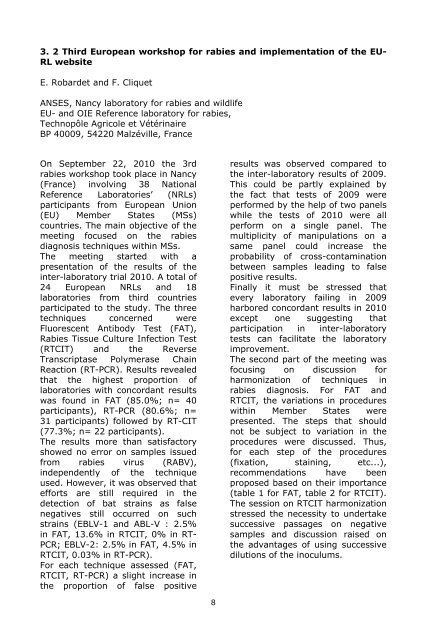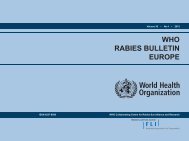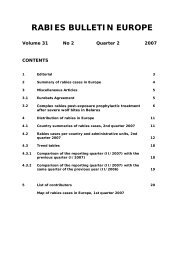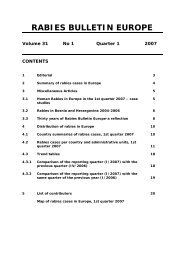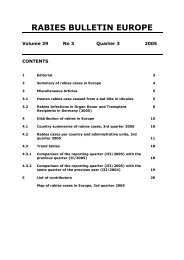4. Quarter - Rabies - Bulletin - Europe
4. Quarter - Rabies - Bulletin - Europe
4. Quarter - Rabies - Bulletin - Europe
You also want an ePaper? Increase the reach of your titles
YUMPU automatically turns print PDFs into web optimized ePapers that Google loves.
3. 2 Third <strong>Europe</strong>an workshop for rabies and implementation of the EU-<br />
RL website<br />
E. Robardet and F. Cliquet<br />
ANSES, Nancy laboratory for rabies and wildlife<br />
EU- and OIE Reference laboratory for rabies,<br />
Technopôle Agricole et Vétérinaire<br />
BP 40009, 54220 Malzéville, France<br />
On September 22, 2010 the 3rd<br />
rabies workshop took place in Nancy<br />
(France) involving 38 National<br />
Reference Laboratories’ (NRLs)<br />
participants from <strong>Europe</strong>an Union<br />
(EU) Member States (MSs)<br />
countries. The main objective of the<br />
meeting focused on the rabies<br />
diagnosis techniques within MSs.<br />
The meeting started with a<br />
presentation of the results of the<br />
inter-laboratory trial 2010. A total of<br />
24 <strong>Europe</strong>an NRLs and 18<br />
laboratories from third countries<br />
participated to the study. The three<br />
techniques concerned were<br />
Fluorescent Antibody Test (FAT),<br />
<strong>Rabies</strong> Tissue Culture Infection Test<br />
(RTCIT) and the Reverse<br />
Transcriptase Polymerase Chain<br />
Reaction (RT-PCR). Results revealed<br />
that the highest proportion of<br />
laboratories with concordant results<br />
was found in FAT (85.0%; n= 40<br />
participants), RT-PCR (80.6%; n=<br />
31 participants) followed by RT-CIT<br />
(77.3%; n= 22 participants).<br />
The results more than satisfactory<br />
showed no error on samples issued<br />
from rabies virus (RABV),<br />
independently of the technique<br />
used. However, it was observed that<br />
efforts are still required in the<br />
detection of bat strains as false<br />
negatives still occurred on such<br />
strains (EBLV-1 and ABL-V : 2.5%<br />
in FAT, 13.6% in RTCIT, 0% in RT-<br />
PCR; EBLV-2: 2.5% in FAT, <strong>4.</strong>5% in<br />
RTCIT, 0.03% in RT-PCR).<br />
For each technique assessed (FAT,<br />
RTCIT, RT-PCR) a slight increase in<br />
the proportion of false positive<br />
results was observed compared to<br />
the inter-laboratory results of 2009.<br />
This could be partly explained by<br />
the fact that tests of 2009 were<br />
performed by the help of two panels<br />
while the tests of 2010 were all<br />
perform on a single panel. The<br />
multiplicity of manipulations on a<br />
same panel could increase the<br />
probability of cross-contamination<br />
between samples leading to false<br />
positive results.<br />
Finally it must be stressed that<br />
every laboratory failing in 2009<br />
harbored concordant results in 2010<br />
except one suggesting that<br />
participation in inter-laboratory<br />
tests can facilitate the laboratory<br />
improvement.<br />
The second part of the meeting was<br />
focusing on discussion for<br />
harmonization of techniques in<br />
rabies diagnosis. For FAT and<br />
RTCIT, the variations in procedures<br />
within Member States were<br />
presented. The steps that should<br />
not be subject to variation in the<br />
procedures were discussed. Thus,<br />
for each step of the procedures<br />
(fixation, staining, etc...),<br />
recommendations have been<br />
proposed based on their importance<br />
(table 1 for FAT, table 2 for RTCIT).<br />
The session on RTCIT harmonization<br />
stressed the necessity to undertake<br />
successive passages on negative<br />
samples and discussion raised on<br />
the advantages of using successive<br />
dilutions of the inoculums.<br />
8


